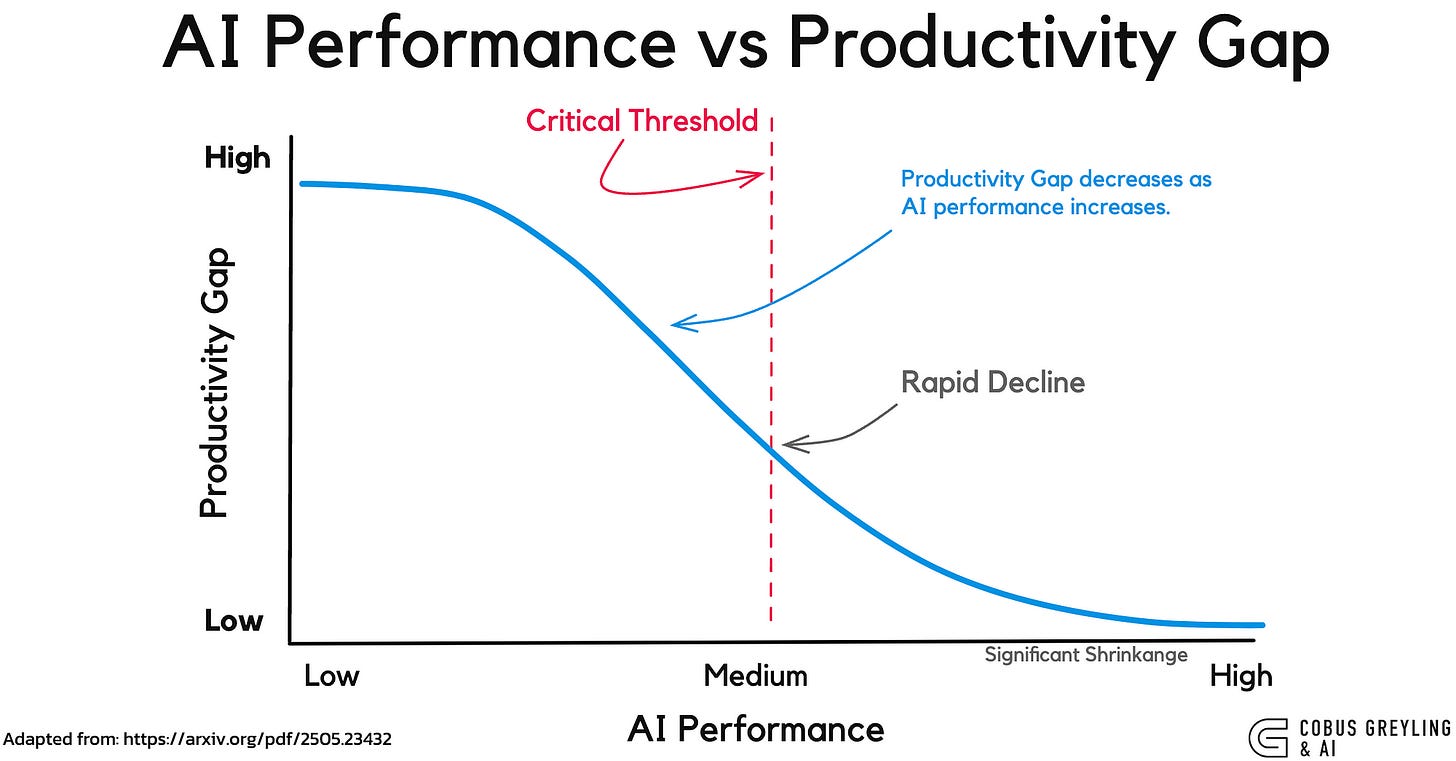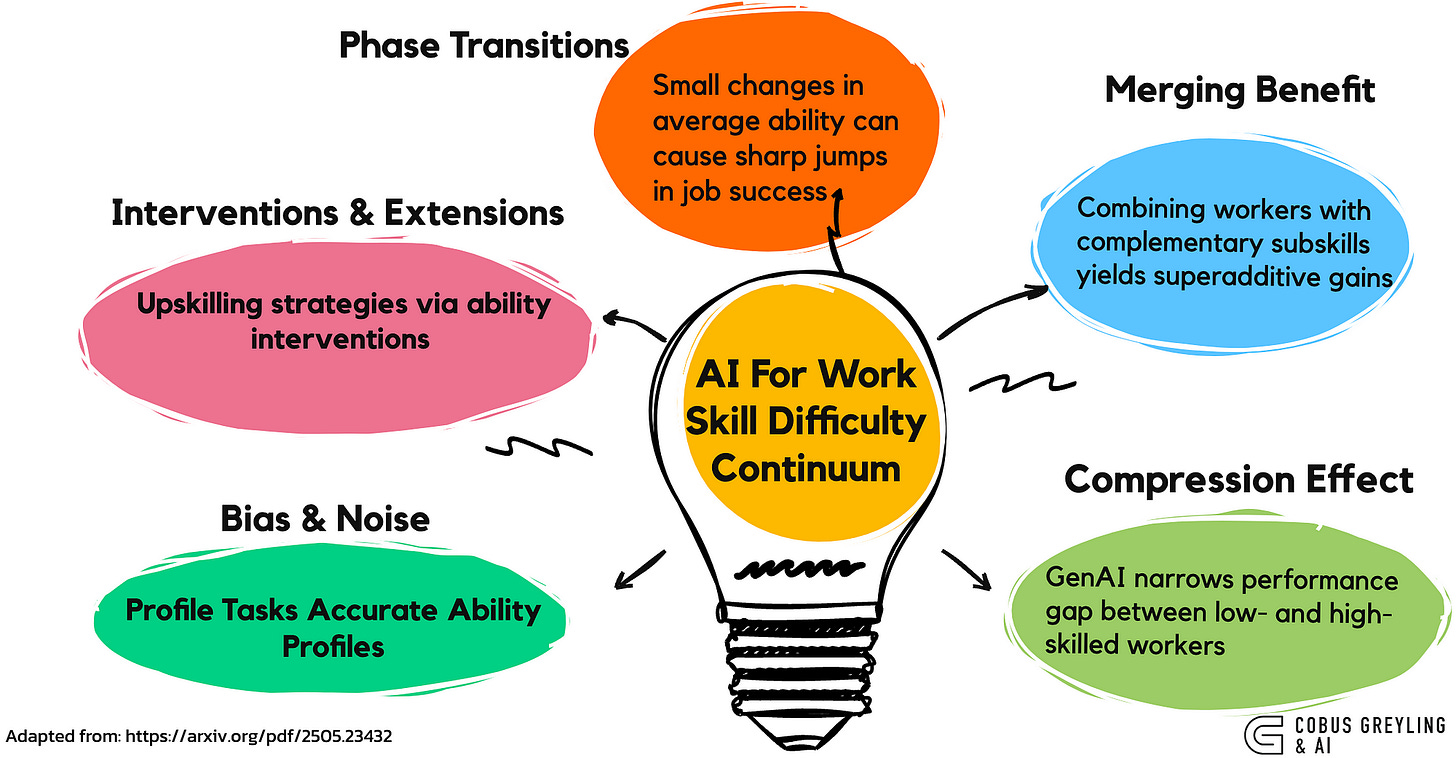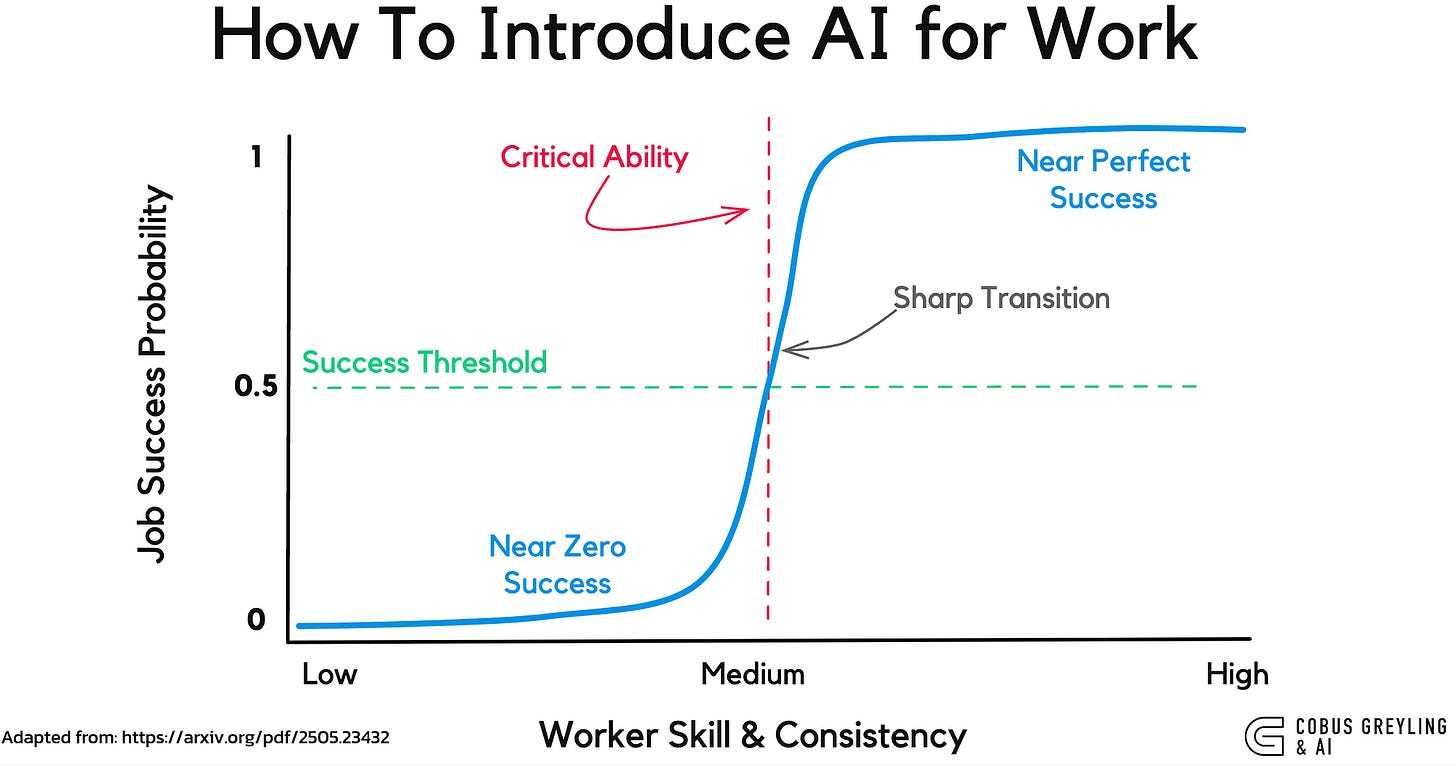Do AI Agents Substitute Human Workers — Or Enable Humans To Succeed In New Ways?
AI Agents are good at tasks, not jobs…
In Short
It took me a while to get my head around this study, to some degree…but I believe it holds a number of valuable considerations around implementing what has been called AI for Work.
Implementing AI in the workplace is not simple and straightforward, as the set of tasks fit into a workday can be complex.
Jobs are modelled as collections of tasks, each requiring multiple skills.
AI Agents excel at tasks — specific, often repetitive activities.
But tasks are not jobs.
Implementing AI in the workplace is not a one size fits all…
GenAI can narrow the performance gap between low and high skilled gaps.
A key feature is the division of skills into two types of subskills:
decision-level (problem solving) and
action-level (solution execution)
Skill difficulty is modelled on a continuum.
Workers, whether human or AI, are characterised by these ability profiles, representing decision- and action-level abilities.
AI improves success likelihood more effectively for workers with lower initial decision-making ability, helping them reach the success threshold, rather than relying on or enhancing high decision-making power alone.
Introduction
The future of work is a hot topic, and tools are poised to replace human workers, or do they enable us to succeed in new, transformative ways?
The answer lies in understanding the nuanced interplay between AI and human skills.
AI for work is complicated…work is complicated…with different skill levels & action levels.
Rather than a simple substitution, AI Agents are changing the workplace by amplifying human capabilities, particularly for less experienced workers, and fostering powerful collaborations that yield extraordinary results.
Do AI Agents substitute for human workers — or enable them to succeed in new ways?

AI Agents are good at tasks, not jobs
AI Agents excel at tasks — specific, often repetitive activities.
But tasks are not jobs.
A job is a complex process of decision-making, problem-solving and contextual understanding, often requiring emotional intelligence and strategic planning — areas where humans still hold the edge.
This distinction is critical.
AI’s strength lies in handling structured, repeatable tasks, freeing humans to focus on higher-order responsibilities.
In one study, AI-assisted customer service agents resolved 14% more issues per hour, demonstrating how AI can amplify efficiency without replacing the human touch.
While GenAI tools perform well on structured or repetitive tasks, they often struggle with skills that require contextual understanding, planning, or emotional intelligence
Productivity Compression
One of the most exciting impacts of AI is its ability to narrow the productivity gap between high- and low-skilled workers — a phenomenon known as productivity compression.
Generative AI (GenAI) tools disproportionately benefit less experienced workers, boosting their output and bringing their performance closer to that of seasoned professionals.
The IMF estimates that nearly 40% of jobs could be affected, raising concerns about large-scale displacement.
Workforce optimisation seeks to align employee skills with organisational objectives to improve productivity, efficiency & satisfaction.
For example, studies show that AI assistance can increase the resolution-per-hour rate of lower-skilled customer service agents by up to 36%, significantly closing the gap with their more skilled counterparts.
This compression effect occurs because AI provides guidance and automation that less experienced workers can leverage to perform tasks more effectively.
Complementary Skills & The Power of Collaboration
Beyond individual gains, AI’s true potential comes to the fore in collaborative settings.
When workers — or workers and AI — combine complementary skills, the results can be superadditive, meaning the whole is greater than the sum of its parts.
Imagine a team where one worker excels at decision-making and another at execution.
Pairing them yields performance far beyond what either could achieve alone.
Now, replace one with an AI Agent tailored to a specific subskill, and the outcome can be even more dramatic.
This merging benefit is supported by research showing that combining workers with distinct ability profiles leads to sharp increases in job success probability.
For example, a GenAI tool might outperform a human in data processing but lag in creative problem-solving.
By merging the AI’s precision with the human’s intuition, organisations can achieve outcomes that neither could deliver independently. This synergy highlights AI’s role not as a replacement but as a collaborator that enhances human potential.

AI’s Role
The graph below shows that for low decision-making ability the success probability is near zero, regardless of AI. As the decision level increases, success jumps sharply once it crosses a critical threshold.
This indicates that a worker’s inherent decision-making ability is a key driver of success.
The graph in the image shows how the probability of successfully completing a job (vertical axis) changes with a worker’s decision-level skill (horizontal axis), under different levels of noise or variability
It illustrates a key idea from the study: as a worker’s skill increases, their chance of success sharply rises — but this transition is sharper (more sudden) when the noise is lower.
In simpler terms, highly consistent workers (low noise) show a dramatic jump in performance once their skill crosses a certain threshold, while more variable workers (higher noise) improve more gradually.
This demonstrates a “phase transition” in success probability and highlights how both skill and reliability affect outcomes.
The study highlights that AI boosts lower-skilled workers’ performance (up to 36% improvement in resolution rates), effectively raising their effective ability for certain tasks.
If workers already have high decision-making ability their success probability is already high without AI, and the additional gain from AI is smaller.
The study’s productivity compression effect shows AI helps lower-skilled workers more, narrowing the gap with higher-skilled ones, rather than requiring or amplifying existing decision-making power.
Challenges
Despite these benefits, integrating AI into workflows isn’t without challenges.
Accuracy, productivity and implementation costs are critical factors.
AI performs best in structured environments but can falter in tasks requiring deep contextual understanding or emotional intelligence.
Also, the effectiveness of AI depends on how well it’s tailored to specific roles and how seamlessly it’s integrated into existing systems.
There’s also the risk of over-reliance.
If organisations lean too heavily on AI for routine tasks, workers may lose opportunities to develop essential skills, potentially stunting long-term growth.
Workforce optimisation — aligning employee skills with organisational goals — requires a balanced approach, ensuring AI complements rather than overshadows human development.
The Bigger Picture
The International Monetary Fund estimates that nearly 40% of jobs could be affected by AI, sparking concerns about displacement.
Yet, the evidence suggests a more optimistic view, AI is less about replacing workers and more about redefining how we work.
By compressing productivity gaps and enabling powerful collaborations, AI Agents empower workers to achieve more, particularly those early in their careers.
The key is strategic integration — using AI to handle tasks where it excels, while preserving the human ingenuity that drives innovation and connection.
For the future, the question isn’t whether AI will substitute for human workers, but how we can harness its potential to find new ways of succeeding.
Chief Evangelist @ Kore.ai | I’m passionate about exploring the intersection of AI and language. From Language Models, AI Agents to Agentic Applications, Development Frameworks & Data-Centric Productivity Tools, I share insights and ideas on how these technologies are shaping the future.



